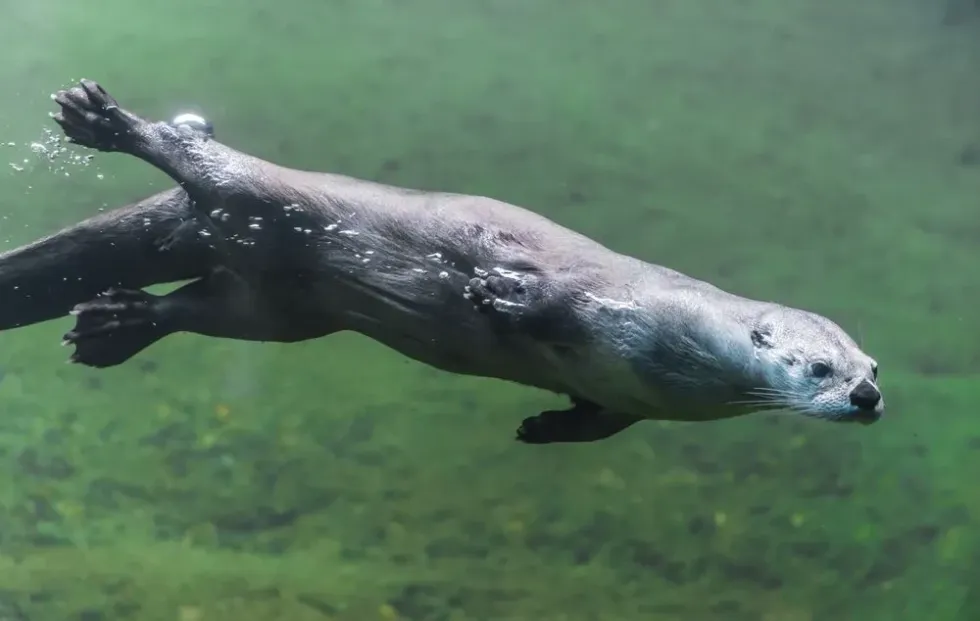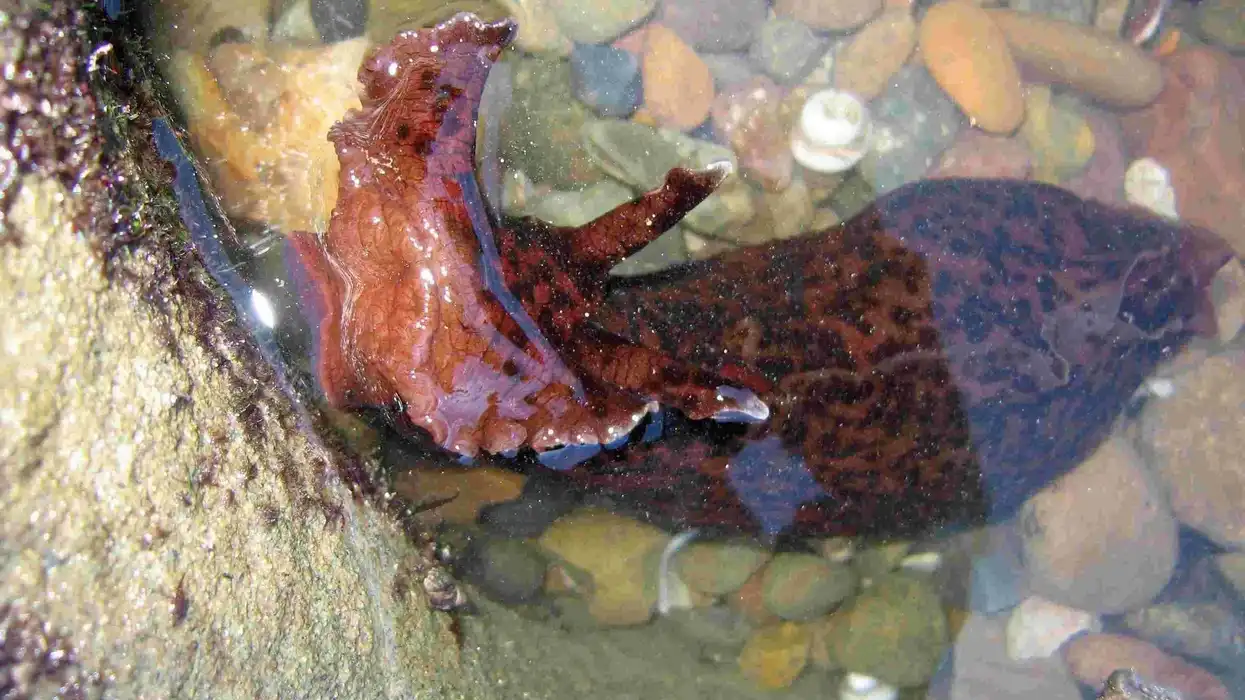Did you know that sea otters are one of the smartest species on the planet? Sea otters have incredible intelligence, even when compared with other animals like dolphins and elephants that humans consider 'smart'.
Wildlife studies have shown that sea otters can stack cups, use tools, and even play basketball! There is a sea otter at the Seattle Aquarium that can use an inhaler and operate a vending machine!
Sea otters use their front paws like hands to grip and open things, which is a behavior seen in very few species apart from humans. They use sharpened rocks as tools and have two pouches on their bodies for storing rocks when not in use!
Apart from their intelligence, sea otters are also incredibly cute! They are small and brown like ferrets, but they live almost exclusively in the ocean.
Unlike other species of otter, which have a permanent burrow as a 'home' on land, sea otter habitats are based in the ocean. They can live their whole lives without ever stepping on land.
They have thick and water-resistant fur—the thickest fur on any marine mammal, in fact! Sea otters were hunted by humans in the 17th and 18th centuries for their fur, which is why they are now considered an endangered species.
For more relatable content, check out these leopard seal facts and fennec fox facts for kids.
Sea Otter Interesting Facts
What type of animal is a sea otter?
A sea otter is a kind of weasel. Weasels are small, rodent-like mammals, who are known for their solitary social habits. The weasel family also includes ferrets, badgers, and polecats.
What class of animal does a sea otter belong to?
Sea otters are marine mammals. They are considered mammals because sea otter females have mammary glands, which produce milk that is consumed by their young.
How many sea otters are there in the world?
The global sea otter population was once estimated to be around 150,000-300,000. However, they were hunted for their thick, waterproof fur in the 18th and 19th centuries.
More recently, the sea otter population has been affected by spills from oil rigs in the ocean as well as run-offs from urban settlements. Despite dedicated conservation efforts, there are only about 3,000 sea otters alive today.
Where does a sea otter live?
Sea otters live mainly in the coastal waters of the North Pacific Ocean. Here, they can snack on sea creatures that hide in the kelp that grows on the ocean floor, or dig into underwater mud for clams! Southern sea otters live near the coast of California.
What is a sea otter's habitat?
The sea otter habitat is based almost entirely on the ocean. Unlike other animals of the weasel family, sea otters don't make their homes in burrows on land.
Although they can't breathe underwater, they feed on sea urchins, clams, snails, and sometimes small fish. These yummy treats are found in beds of kelp or in the soft mud that lies at the bottom of the ocean floor. That's why you'll find this marine mammal living in coastal waters.
The ocean floor is sloping—it is high in the coastal region and lowers in open waters. Sea otters live near the shore, so they don't have to hold their breath for too long while they forage for food!
Who do sea otters live with?
Baby sea otters, also called pups, live with their mothers for six months. When they grow up and learn to catch their own food, they 'move out' and start to live alone.
Male sea otters are solitary animals who have a territory, a patch of water where they don't allow any other males to live. Female sea otters are more nomadic.
They float through several territories as they look for mates. Sea otters who don't have their own territories are also known to nap together in formations called ‘rafts’. These rafts are distributed by sex, meaning male otters will nap with other males and female otters will nap with other females.
Sea otters will often hold hands as they nap. They also wrap kelp around them like blankets so that they don't drift off into the ocean!
How long does a sea otter live?
Sea otters are prey to very few natural predators and have a good rate of survival as pups. They can live from 10-15 years in the wild.
Their lifespan can be shortened by the presence of pollutants in ocean water, such as human waste or spilled oil. In the '90s, the populations of California sea otters began to decline mysteriously. Marine biologists realized that sea otters are susceptible to many bacterial and fungal infections.
How do they reproduce?
Sea otters are polygynous: one male will mate with several females during a mating season. When a male sea otter finds a female who accepts him, they play together in the water before mating. The female sea otter will give birth to a pup approximately six months after conception.
What is their conservation status?
Sea otters were historically hunted for their extra dense fur, which can grow up to a million hairs per square inch. This made sea otter populations decline from 300,000 to 3,000!
The Endangered Species Act of 1973 categorized sea otters as an Endangered species. California sea otters are slightly higher in number, but the US Fish and Wildlife Service has still labeled their conservation status as Threatened.
Sea otters are a keystone species, which means that they are vital to the maintenance of their ecosystems. Sea otters eat marine herbivores like sea urchins, making sure that those herbivores don't eat up all the kelp on the ocean floor.
Kelp forests are home to various species of marine animals, which all depend on the sea otter for their homes!
Sea Otter Fun Facts
What do sea otters look like?
Sea otters are long, furry marine mammals and wildlife that look like a cross between seals and ferrets. Their bodies are flexible and lined with thick, water-repellent fur with many hairs per square inch.
How cute are they?
Southern sea otters are extremely cute, with their velvety fur and little paws. However, they are wild animals with sharp teeth and claws that can injure you if you get too close. So don't try to pet a sea otter unless it is specifically domesticated!
How do they communicate?
Sea otters often communicate vocally by producing loud noises. There are nine types of vocalizations identified by wildlife experts in sea otters. Female sea otters coo when they are content. Male sea otters typically grunt instead. Sea otters even scream or shriek when they feel threatened!
How big is a sea otter?
A sea otter is about five times smaller than an adult human. Depending on their sub-species and origin, sea otters can measure up to 4.9 ft (1.5 m) when standing on their hind legs.
How fast can a sea otter move?
A Southern sea otter can swim as fast as 5.6 mph (9 kph).
How much does a sea otter weigh?
An adult sea otter's weight can be up to 55 lb (25 kg). Sea otters are heavier than river otters due to their thicker fur. Alaska sea otters, also known as northern sea otters, are bigger and heavier than California sea otters, or southern sea otters. The biggest sea otter ever measured was 119 lb (54 kg)!
What are the male and female names of the species?
Males and females are both called sea otters.
What would you call a baby sea otter?
A baby sea otter is called a pup.
What do they eat?
Sea otters spend up to 60 percent of their time hunting for food on the ocean floor. California sea otters eat sea urchins, worms, snails, and some kinds of small fish in wildlife.
They also prey on clams, which they break open with rocks. You can often find a sea otter floating belly up in the water, trying to open a shellfish prey with its front paws!
Are they dangerous?
Sea otters look too cute to be dangerous, but they can be quite aggressive wildlife when threatened. There are many instances of sea otters attacking other animals such as seals.
Adult male sea otters patrol their chosen territories around mating season and can attack rival males if they are found encroaching upon the otter's territory.
The presence of otters in small water bodies can attract coyotes and foxes, who prey on them, into human neighborhoods. In a river otter vs sea otter competition over who is more dangerous to humans, river otters would win hands down!
Would they make a good pet?
Although North sea otters are sometimes kept as exotic pets, they are wild animals and do not make good pets. Their natural habitat is the ocean. They need to be left alone to swim and float in as much space as they please.
Did you know...
Every sea otter has a unique scent that identifies its age, species, breeding status, and identity. This scent is as unique to a sea otter as fingerprints are to a human being!
Is the sea otter endangered?
Yes, the sea otter is an endangered animal. Sea otters were hunted for their dense, velvety fur, which made their population decrease from 300,000 to 3,000 in the wild. Sea otters are protected under the Endangered Species Act of 1973. Despite efforts to conserve them in the 20th century, sea otter populations have been slow to recover.
Where can I pet a sea otter?
You can pet a sea otter at an aquarium. Never try to pet a sea otter in the wild!
Here at Kidadl, we have carefully created lots of interesting family-friendly animal facts for everyone to discover! For more relatable content, check out these giant anteater facts and plains zebra facts pages.
You can even occupy yourself at home by coloring in one of our free printable sea otter coloring pages.









